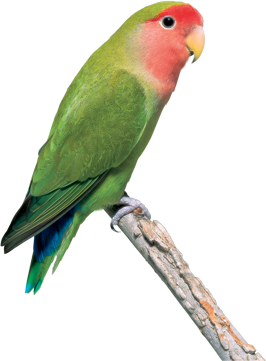Profiles
PEACH-FACED LOVEBIRD
(AgapornisRoseicollis)
Family: African Lovebird – several species including Masked Lovebird, Nyassa Lovebird and Fischers Lovebird.
Origin: South and southwest Africa.
Size: 150mm
Description:
The peach pink extends from this bird’s face to its breast. The lower body feathers are light-green and the wings are a darker shade of green. Its lower back is blue, and the very short tail is green with black, red and blue markings.
The plumage is very similar in both the cock and he hen. And during the breeding season it is only the hen that will collect and carry bits of bark to line the nest
Care:
Breeding can be achieved in large cages, but an aviary with a flight attached for each pair is best. Provide natural twigs of apple, pear or willow to help ease any damage caused by birds gnawing on their nest boxes.
A log with plenty of bark is ideal to place on the floor of the aviary because the hen will pick off pieces and tuck it between the feathers of her wings and carry them back up to her nesting box. They also prefer a hanging site for their nests.
They also like hollow logs that they can pack with short twigs and stalks of grasses for their nests and these too should be securely suspended from the roof of the aviary.
Eats:
A good quality small parrot mix consisting of canary, millets, buckwheat, sunflower and linseed should be given. Fresh fruit and greens, cuttlefish bone, grit and fresh water also needs to be provided regularly.
Features:
Sexing these birds is not easy – the hen lays four to five eggs and the incubation lasts for 23 days. The cock will gather food and feed the hen during this time and will also feed the chicks once they have hatched and keep feeding them until 35 days after leaving the nest.
They breed throughout the year but do not over breed.
Call:
They have a musical whistle with a piercing yodelling and if there are any other lovebirds nearby they will quickly join in, and it appears to be a warning or gathering call. When relaxed they will quietly chatter away.
Personality:
Though they look like the “darlings” of the bird set they do have a dark side and should never be housed with birds that are not of their kind because they will bite the feet off other birds.
Their softer side is displayed when rearing their chicks as they are totally devoted and caring.
They are lively, comical and usually breed well in captivity.
